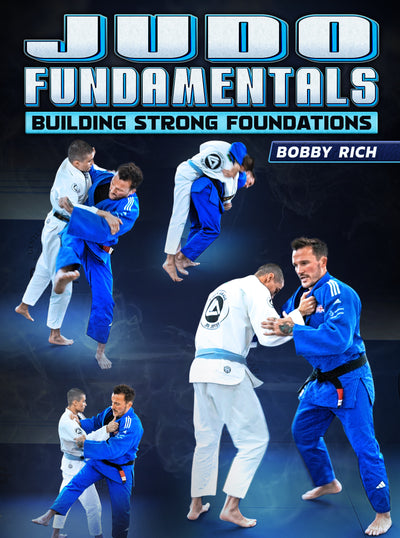Drop Seoi Nage With Travis Stevens
Seoi Nage (meaning shoulder throw in English) is one of the core forty throws in Jigoro Kano’s Gokyo of Kodokan Judo. It’s a part of the Dai Ikkyo (first group) of techniques that all Judoka learn and therefore is a staple of Judo’s tachi waza (standing techniques). Seoi Nage is a very powerful throw with great transitional options for ne waza (ground techniques).
Who better to show us a variation of Seoi Nage, Drop Seoi Nage, than Olympic Silver medalist Judoka and Black Belt under John Danaher Travis Stevens?
Traditionally standing Seoi Nage is executed from an orthodox sleeve and lapel grip with kuzushi (breaking balance) attained by pulling your opponent forward onto the balls of their feet or forward and to their right. This pulling is done using both sleeve and lapel being drawn towards you and up while the lapel side foot moves to it’s opposite side as you rotate so that your back is against you opponents chest. Your lapel grip arm’s elbow moves deeply through to the opposite side of your opponents body and your sleeve grip maintains tight control of your opponents arm close in to your body.
Ready to Join The Judo Academy!? Click Learn More!
As you step through to gain back to chest contact with your opponent it is important that you maintain your own weight in the balls of your feet so that it’s easier for you to sink your hips down underneath your opponents center of gravity. A common way of thinking about this is to make sure your belt line is below your opponents belt line. A second reason it’s good to slightly float your heels and stay on the balls of your feet is that if while stepping through for the throw your weight is in your heels you will tend to lose your balance backward and be vulnerable to counter throws from your opponent.
Now your opponent is loaded onto your back and their balance is broken we are in the perfect position to finish Seoi Nage. We bring both arms and hands through the throw with a circular motion pulling our opponent through the throw to complete our shoulder throw. One important point to note here is working on this with a partner is to pull them upwards as they land to reduce the impact on your partner. This also ingrains the positive habit of maintaining control of your opponents arm for transitions to ne waza (ground techniques).
Drop Seoi Nage employs the same basic principles as standing Seoi Nage but the crucial difference that Travis demonstrates is that instead of gaining back to chest contact we are turning so that our back faces our opponent but as we do so we are also jumping through the gap between our opponents legs and landing on our shins and knees. This considerably drops our center of gravity in comparison to standing Seoi Nage and creates a strong fulcrum for our shoulder throw to side control.
As with standard Seoi Nage our kuzushi (breaking balance) is to pull our opponent up and forwards and the arm of our collar grip comes across the opponents body to underneath their armpit. This arm of our collar grip creates an important frame for us to throw our opponent which we must maintain the shape of during the throw. As Travis demonstrates, due to the nature of Drop Seoi Nage putting us so far underneath our opponent if we collapse the frame that our collar grip arm gives us then our opponents body weight comes down directly on top of us, which leaves us wide open for them to take our backs; a terrible reversal we want to avoid!
As we maintain our throwing frame we pull in and down with our sleeve grip and push through with the koshi (hips) as we extend our legs to lift our opponent and roll them through the throw to land in a strong side control position. Travis notes that a key detail to this throw is a wave-like kuzushi, which begins with opening our opponents up and outwards at the beginning of the throw and then pulling them to a closed and downwards posture at the fulcrum of the throw. As always control of posture, balance, and timing is crucial for Drop Seoi Nage and is why progressive drilling is so helpful to build this powerful tachi waza, or standing technique.
One key detail of the pulling up and forward phase of kuzushi here is that our opponent will react against this by initiating a squat motion, freezing their feet to the floor. This freeze gives us the window we need to get the penetration of their posture we need to sink our weight so far beneath them.
Travis notes a few common mistakes with Drop Seoi Nage. As Drop Seoi Nage involves a dramatic drop it’s tempting to think it’s the drop by itself that makes the technique work. Trying to bypass the crucial kuzushi for Drop Seoi Nage however means that our opponent will remain mobile and we will very likely fall short, meaning our opponent will easily stuff the throw.
The second mistake people can make with Drop Seoi Nage is simply not dropping deep enough even though all previous steps were executed correctly. We must get a deep drop underneath our opponent otherwise we are making it very easy for our opponent to stuff our takedown and take our back.
Get all these details right with Drop Seoi Nage however and we have a powerful throw that not only gives us transition to side control on the floor but such a deep roll at the end of the throw that we have a window to start a back control of our own!

If you want to see more game changing information from Olympian Judokas Travis Stevens and Jimmy Pedro then check out The Judo Academy here!



